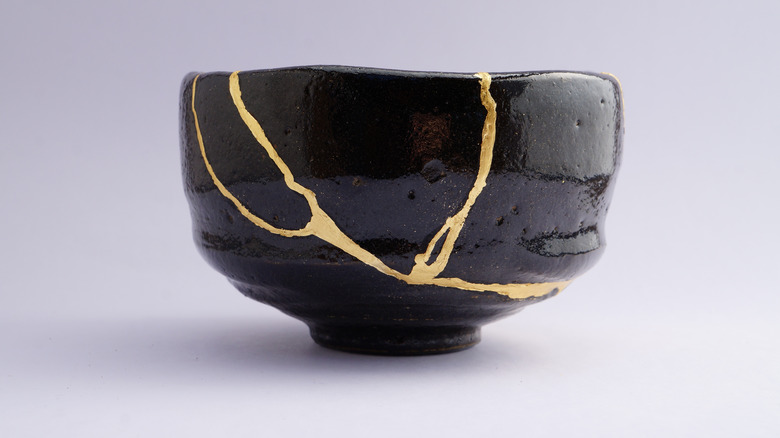How The Japanese Art Of Repairing With Gold Can Help You Embrace Your Imperfections
When an object breaks, your first instinct might be to throw it away. After all, it will no longer be the same as it was; it might no longer be useful or beautiful. But the Japanese think otherwise. In the 16th or 17th century, kintsugi, the practice of using gold to mend broken pieces of ceramics together, became the norm. Kintsugi's origins are hazy. Louise Cort, a ceramics curator at the Smithsonian, told Artsy that she believes that the practice of kintsugi spread thanks to Japanese tea ceremonies.
Cort also explained that there is a legendary story behind the first use of kintsugi. It's said that a Chinese bowl owned by a Japanese soldier broke. The soldier asked for another of the same bowl, but the Chinese said they did not have one. Instead, they crudely repaired it with staples, and kintsugi was born.
The BBC reports that kintsugi translates into "to join with gold." Artisans would fix the broken ceramics using a mixture of lacquer, tree sap, and powdered gold. But kintsugi is more than an art form. It has become a philosophy for dealing with the curveballs that life throws at you and the internal wounds you have developed as a result.
If you or someone you know needs help with mental health, please contact the Crisis Text Line by texting HOME to 741741, call the National Alliance on Mental Illness helpline at 1-800-950-NAMI (6264), or visit the National Institute of Mental Health website.
Kintsugi and healing
Sometimes, you have to dig deep to find the root of the problem to heal. The philosophy of kintsugi can help with this. At its core, kintsugi denotes that life is filled with positive and negative experiences. Even if you get broken along the journey, you will be stronger for it. Kintsugi urges you to see yourself not as a victim but as a warrior who has survived, flaws and all. Celine Santini, author of "Kintsugi: Finding Strength in Imperfection," explained this concept further to Wellbeing Magazine.
She said, "It has to do with the symbolism of healing and resilience. First taken care of and then honored, the broken object accepts its past and paradoxically becomes more robust, more beautiful, and more precious than before it was broken." In other words, you should not be ashamed of your scars or imperfections; you should honor them because they are now a part of you. Accepting this can be a step toward the right direction in healing.
Kintsugi is similar to another Japanese concept: wabi-sabi. Wabi-sabi says that things are beautiful because they are imperfect. Nevertheless, kintsugi and wabi-sabi are centered on how someone deals with adversity. You can let it break you or come out of it as a better and wiser person.
Kintsugi's other lessons
Honoring yourself and your flaws through kintsugi can be a way to care for your mental health if you can't afford therapy. This thinking can apply to any hardship, such as the end of a relationship, grief, and more. You can use kintsugi to reflect on the silver linings of whatever adversity you have gone through. For example, maybe you feel more creative or at peace with your life. Or perhaps your relationships have benefited from your ability to heal and accept yourself.
In an article for Shine, Candice Kumai, author of "Kintsugi Wellness: The Japanese Art of Nourishing Mind, Body, and Spirit," wrote that it's a philosophy full of lessons. She said, "Through kintsugi, I learned it's okay to hurt and grieve. It is okay to be vulnerable. It is okay to accept and allow yourself the time to share, to open up, to exercise compassion." Kumai explained that kintsugi taught her that the first step in forgiveness is forgiving yourself and that she has accepted that she will never stop learning from her mistakes. In addition, Kumai noted that you can't change what has happened in your life, but you can change how you move forward.
Kumai told Wellbeing Magazine that even if you have suffered, kintsugi can allow you to live life to the fullest."The realization is that pain awakens you and makes you feel alive. It will remind you of what is important and how without darkness, light cannot exist," she said.


